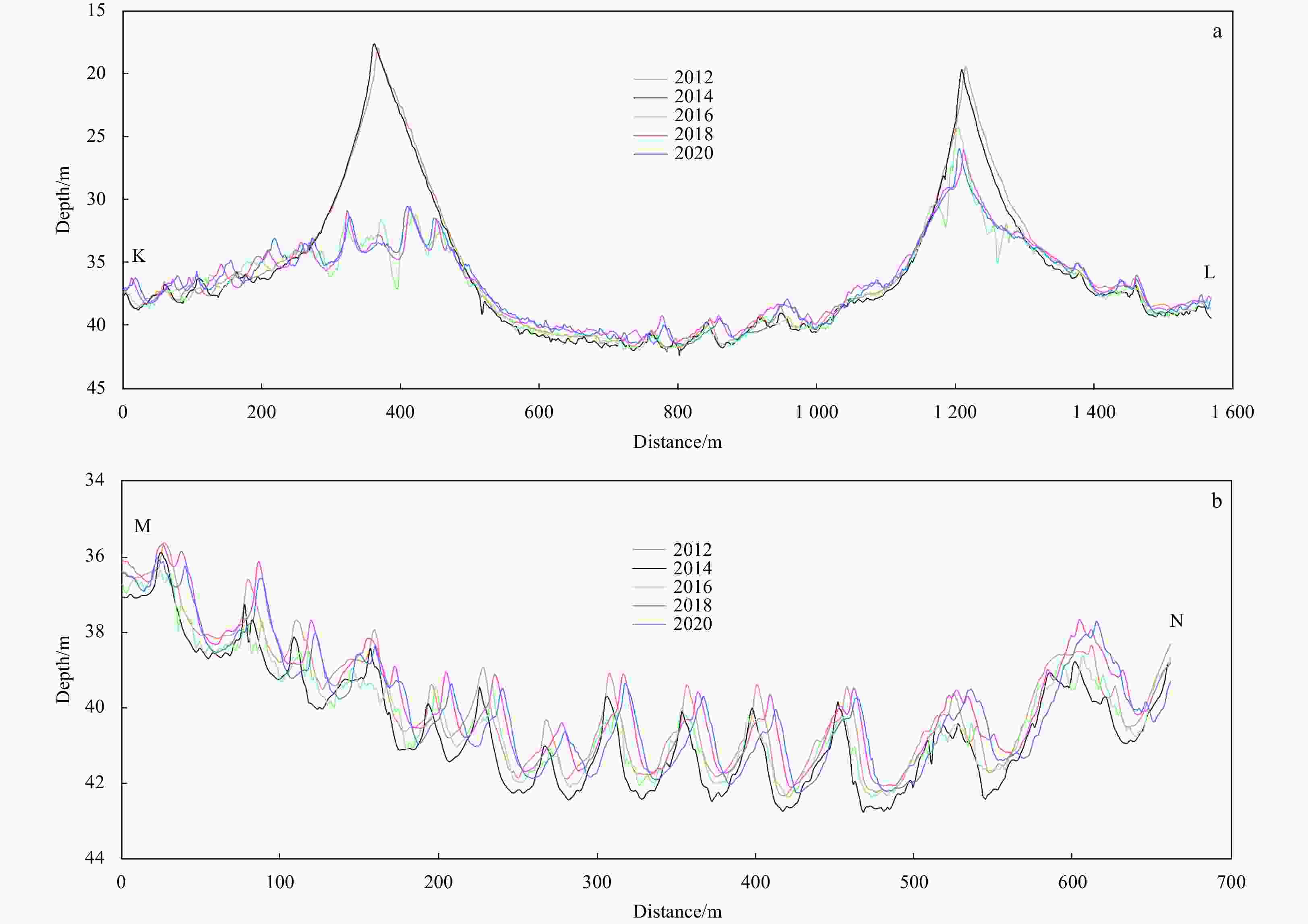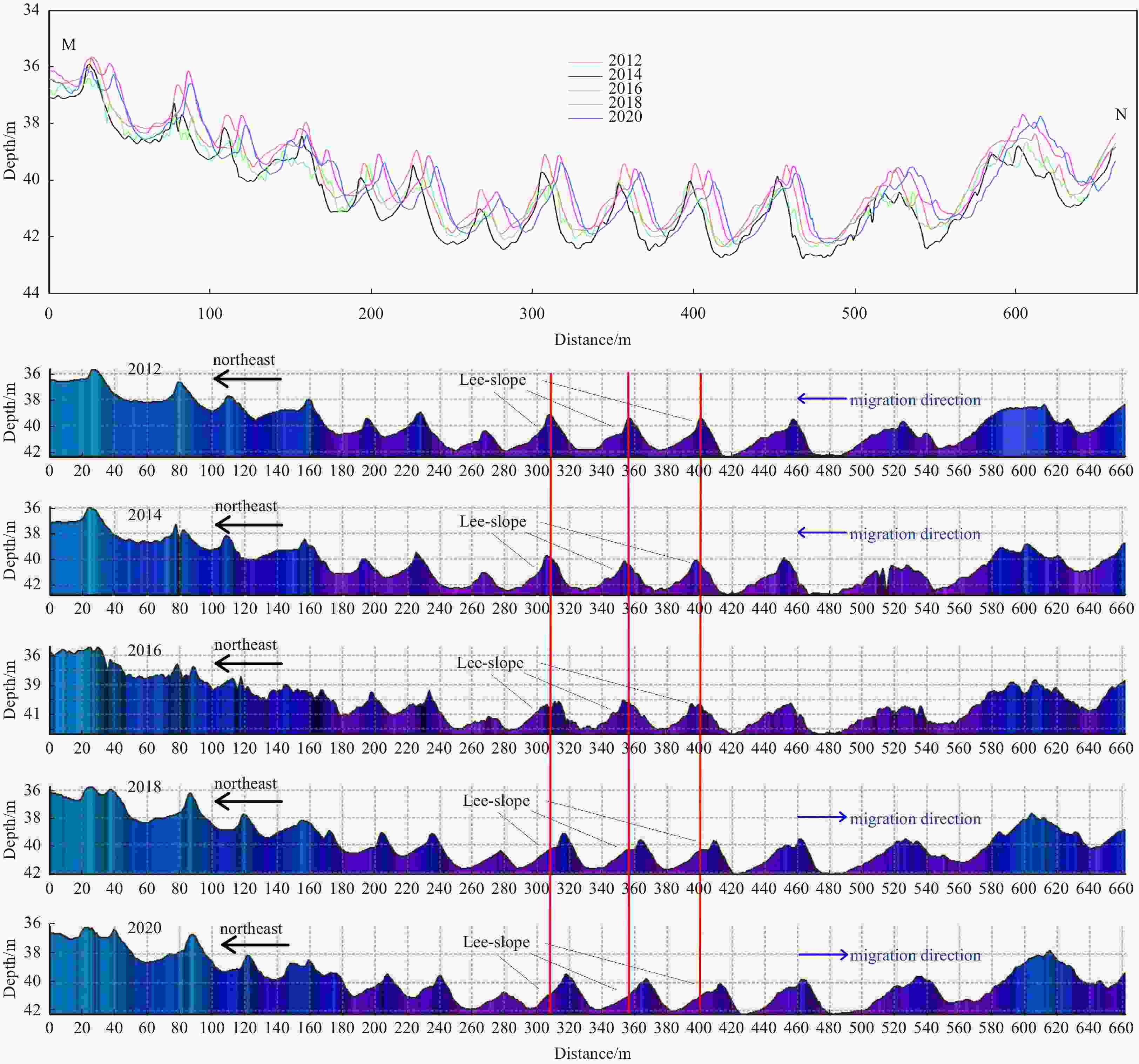Regeneration and anti-migration of sand waves associated with sand mining in the Taiwan Shoal
-
Abstract: Sand waves in the Taiwan Shoal are characterized by two distinct spatial scales. Giant sand waves have a length of 2 kilometers with height between 5 m and 25 m, whilst small sand waves is less than 100-m long with height less than 5 m between giant sand wave peaks (crests). A series of five high-resolution multi-beam echo-sounding surveys between 2012 and 2020 in the middle of Taiwan Shoal indicated that artificial dredging on the giant sand waves had caused sand wave reform and evolution. Overall, the removal of giant sand waves significantly affected the migration of small sand waves adjacent to the dredging site, with the latter on both sides of the former appear to migrate towards the dredging pit. Moreover, in the dredging area, new sand waves emerged with wavelength much smaller than the original giant sand waves, while the convergent pattern of the small sand waves tends to store and form the giant sand waves, which might spread far beyond the survey period.
-
Key words:
- small sand wave /
- giant sand wave /
- anti-migration /
- regrowing /
- sand mining /
- Taiwan Shoal
-
Figure 1. Location of Taiwan Shoal in the south of Taiwan Strait, showing sand wave dredging site (modified from Bao et al. (2020)).
Figure 3. Crest line profiles of KL for the giant sand waves (a) and MN for the small sand waves (b) in the five surveys during 2012 and 2020 (refer to Fig. 2)
-
Bao Jingjing, Cai Feng, Ren Jianye, et al. 2014. Morphological characteristics of sand waves in the middle Taiwan Shoal based on multi-beam data analysis. Acta Geologica Sinica (English Edition), 88(5): 1499–1512. doi: 10.1111/1755-6724.12314 Bao Jingjing, Cai Feng, Shi Fengyan, et al. 2020. Morphodynamic response of sand waves in the Taiwan Shoal to a passing tropical storm. Marine Geology, 426: 106196. doi: 10.1016/j.margeo.2020.106196 Berné S, Vagner P, Guichard F, et al. 2002. Pleistocene forced regressions and tidal sand ridges in the East China Sea. Marine Geology, 188(3–4): 293–315. doi: 10.1016/S0025-3227(02)00446-2 Besio G, Blondeaux P, Brocchini M, et al. 2004. On the modeling of sand wave migration. Journal of Geophysical Research: Oceans, 109(C4): C04018. doi: 10.1029/2002JC001622 Campmans G H P, Roos P C, De Vriend H J, et al. 2017. Modeling the influence of storms on sand wave formation: A linear stability approach. Continental Shelf Research, 137: 103–116. doi: 10.1016/j.csr.2017.02.002 Campmans G H P, Roos P C, De Vriend H J, et al. 2018. The influence of storms on sand wave evolution: A nonlinear idealized modeling approach. Journal of Geophysical Research: Earth Surface, 123(9): 2070–2086. doi: 10.1029/2018JF004616 Campmans G H P, Roos P C, Van der Sleen N R, et al. 2021. Modeling tidal sand wave recovery after dredging: Effect of different types of dredging strategies. Coastal Engineering, 165: 103862. doi: 10.1016/j.coastaleng.2021.103862 Chen Hsien-Wen, Liu Cho-Teng, Matsuno T, et al. 2016. Temporal variations of volume transport through the Taiwan Strait, as identified by three-year measurements. Continental Shelf Research, 114: 41–53. doi: 10.1016/j.csr.2015.12.010 Chuang Wen-Ssn, Li Hsien-Wen, Tang Tswen Yung, et al. 1993. Observations of the countercurrent on the inshore side of the Kuroshio northeast of Taiwan. Journal of Oceanography, 49(5): 581–592. doi: 10.1007/BF02237464 Du Xiaoqin, Gao Shu, Li Yan. 2010. Hydrodynamic processes and bedload transport associated with large-scale sandwaves in the Taiwan Strait. Journal of Coastal Research, 26(4): 688–698 Hanes D M. 2012. The genesis of an inter-field marine sandwave and the associated anti-asymmetry migration of neighboring crests. Geophysical Research Letters, 39(4): L04402. doi: 10.1029/2011GL050641 Harris P T. 1991. Reversal of subtidal dune asymmetries caused by seasonally reversing wind-driven currents in Torres Strait, northeastern Australia. Continental Shelf Research, 11(7): 655–662. doi: 10.1016/0278-4343(91)90018-2 Hong Huasheng, Zhang Caiyun, Shang Shangling, et al. 2009. Interannual variability of summer coastal upwelling in the Taiwan Strait. Continental Shelf Research, 29(2): 479–484. doi: 10.1016/j.csr.2008.11.007 Hu Jianyu, Kawamura Hiroshi, Li Chunyan, et al. 2010. Review on current and seawater volume transport through the Taiwan Strait. Journal of Oceanography, 66: 591–610. doi: 10.1007/s10872-010-0049-1 Hu Zifeng, Qi Yiquan, He Xianqiang, et al. 2019. Characterizing surface circulation in the Taiwan Strait during NE monsoon from Geostationary Ocean Color Imager. Remote Sensing of Environment, 221: 687–694. doi: 10.1016/j.rse.2018.12.003 Hulscher S J M H. 1996. Tidal-induced large-scale regular bed form patterns in a three-dimensional shallow water model. Journal of Geophysical Research: Oceans, 101(C9): 20727–20744. doi: 10.1029/96JC01662 Hulscher S J M H, Knaapen M A F, Scholl O. 2000. Regeneration of dredged sand waves.Proceedings of Marine sandwave Dynamics, 23–24 IHO. 2008. IHO Standards for Hydrographic Surveys, S-44. 5th ed. Monaco: International Hydrographic Organization, 1–23 Jan Sen, Chao Shenyu. 2003. Seasonal variation of volume transport in the major inflow region of the Taiwan Strait: the Penghu Channel. Deep Sea Research Part II: Topical Studies in Oceanography, 50(6−7): 1117–1126. doi: 10.1016/S0967-0645(03)00013-4 Katoh K, Kume H, Kuroki K, et al. 1998. The development of sand waves and the maintenance of navigation channels in the Bisanseto Sea. In: Proceedings of the 26th International Conference on Coastal Engineering. Copenhagen: ASCE, 3490–3502 Knaapen M A F, Hulscher S J M H. 2002. Regeneration of sand waves after dredging. Coastal Engineering, 46(4): 277–289. doi: 10.1016/S0378-3839(02)00090-X Knaapen M A F, Hulscher S J M H, Scholl O. 2000. Can we predict the growth of sand waves? Hindcast of a field experiment in the Bisanseto Sea, Japan. In: Proceedings of the 27th International Conference on Coastal Engineering. Sydney, ASCE, 2661–2671. doi: 10.1061/40549(276)208 Li Li, Guo Xiaogang, Liao Enhui, et al. 2018. Subtidal variability in the Taiwan Strait induced by combined forcing of winter monsoon and topography. Science China Earth Sciences, 61(4): 483–493. doi: 10.1007/s11430-016-9132-9 Liu Zhenxia, Xia Dongxing, Berné S, et al. 1998. Tidal deposition systems of China’s continental shelf, with special reference to the eastern Bohai Sea. Marine Geology, 145(3–4): 225–253. doi: 10.1016/S0025-3227(97)00116-3 McCave I N. 1971. Sand waves in the North Sea off the coast of Holland. Marine Geology, 10(3): 199–225. doi: 10.1016/0025-3227(71)90063-6 Oey Lie-Yauw, Chang Yu-Lin, Lin Yu Chun, et al. 2014. Cross flows in the Taiwan Strait in winter. Journal of Physical Oceanography, 44(3): 801–817. doi: 10.1175/JPO-D-13-0128.s1 Off T. 1963. Rhythmic linear sand bodies caused by tidal currents. AAPG Bulletin, 47(2): 324–341 Shen Junqiang, Qiu Yun, Guo Xiaogang, et al. 2017. The spatio-temporal variation of wintertime subtidal currents in the western Taiwan Strait. Acta Oceanologica Sinica, 36(11): 4–13. doi: 10.1007/s13131-017-1120-1 Shen Junqiang, Zhang Junpeng, Qiu Yun, et al. 2019. Winter counter-wind current in western Taiwan Strait: Characteristics and mechanisms. Continental Shelf Research, 172: 1–11. doi: 10.1016/j.csr.2018.11.005 Terwindt J H J. 1971. Sand waves in the southern bight of the North Sea. Marine Geology, 10(1): 51–67. doi: 10.1016/0025-3227(71)90076-4 Van de Meene J W H, Boersma J R, Terwindt J H J. 1996. Sedimentary structures of combined flow deposits from the shoreface-connected ridges along the central Dutch coast. Marine Geology, 131(3–4): 151–175. doi: 10.1016/0025-3227(95)00074-7 Verboven I. 2017. Regeneration of tidal sand waves after dredging field data analysis, model simulations, and synthesis to dredging strategies [dissertation]. Enschede: University of Twente Wang Yuhuai, Jan Sen, Wang Dongping. 2003. Transports and tidal current estimates in the Taiwan Strait from shipboard ADCP observations (1999–2001). Estuarine, Coastal and Shelf Science, 57(1–2): 193–199, Wang Li, Pawlowicz R, Wu Xiongbin, et al. 2021. Wintertime variability of currents in the southwestern Taiwan Strait. Journal of Geophysical Research: Oceans, 126(5): e2020JC016586. doi: 10.1029/2020JC016586 Zhou Jieqiong, Wu Ziyin, Jin Xianglong, et al. 2018. Observations and analysis of giant sand wave fields on the Taiwan Banks, northern South China Sea. Marine Geology, 406: 132–141. doi: 10.1016/j.margeo.2018.09.015 -





 下载:
下载:









